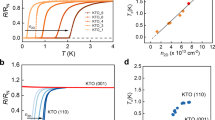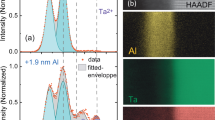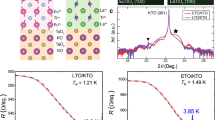Abstract
Superconductivity at interfaces has been investigated since the first demonstration of electric-field-tunable superconductivity in ultrathin films in 19601. So far, research on interface superconductivity has focused on materials that are known to be superconductors in bulk1,2,3,4,5,6,7,8,9. Here, we show that electrostatic carrier doping can induce superconductivity in KTaO3, a material in which superconductivity has not been observed before10,11. Taking advantage of the large capacitance of the self-organized electric double layer that forms at the interface between an ionic liquid and KTaO3 (ref. 12), we achieve a charge carrier density that is an order of magnitude larger than the density that can be achieved with conventional chemical doping. Superconductivity emerges in KTaO3 at 50 mK for two-dimensional carrier densities in the range 2.3 × 1014 to 3.7 × 1014 cm−2. The present result clearly shows that electrostatic carrier doping can lead to new states of matter at nanoscale interfaces.
This is a preview of subscription content, access via your institution
Access options
Subscribe to this journal
Receive 12 print issues and online access
$259.00 per year
only $21.58 per issue
Buy this article
- Purchase on Springer Link
- Instant access to full article PDF
Prices may be subject to local taxes which are calculated during checkout





Similar content being viewed by others
References
Glover, R. E. & Sherrill, M. D. Changes in superconducting critical temperature produced by electrostatic charging. Phys. Rev. Lett. 5, 248–250 (1960).
Mannhart, J., Bednorz, J. G., Müller, K. A. & Schlom, D. G. Electric field effect on superconducting. YBa2Cu3O7–δ films. Z. Phys. B 83, 307–311 (1991).
Ahn, C. H. et al. Electrostatic modulation of superconductivity in ultrathin GdBa2Cu3O7– x films. Science 284, 1152–1155 (1999).
Parendo, K. A., et al. Electrostatic tuning of the superconductor–insulator transition in two dimensions. Phys. Rev. Lett. 94, 197004 (2005).
Takahashi, K. S. et al. Local switching of two-dimensional superconductivity using the ferroelectric field effect. Nature 441, 195–198 (2006).
Reyren, N. et al. Superconducting interfaces between insulating oxides. Science 317, 1196–1199 (2008).
Ueno, K. et al. Electric-field-induced superconductivity in an insulator. Nature Mater. 7, 855–858 (2008).
Kozuka, Y. et al. Two-dimensional normal-state quantum oscillations in a superconducting heterostructure. Nature 462, 487–490 (2009).
Ye, J. T. et al. Liquid-gated interface superconductivity on an atomically flat film. Nature Mater. 9, 125–128 (2010).
Wemple, S. H. Some transport properties of oxygen-deficient single-crystal potassium tantalite (KTaO3). Phys. Rev. 137, A1575–A1582 (1965).
Thompson, J. R., Boatner, L. A. & Thomson, J. O. Very low-temperature search for superconductivity in semiconducting KTaO3 . J. Low Temp. Phys. 47, 467–475 (1982).
Yuan, H. T. et al. High-density carrier accumulation in ZnO field-effect transistors gated by electric double layers of ionic liquids. Adv. Func. Mater. 19, 1046–1053 (2009).
Bednorz, J. G. & Müller. K. A. Possible high Tc superconductivity in the Ba–La–Cu–O system. Z. Phys. B 64, 189–193 (1986).
Bhattacharya, A., Eblen-Zayas, M., Staley, N. E., Huber, W. H. & Goldman, A. M. Micromachined SrTiO3 single crystals as dielectrics for electrostatic doping on thin films. Appl. Phys. Lett. 85, 997–999 (1994).
Parendo, K. A. et al. Electrostatic tuning of the superconductor–insulator transition in two dimensions. Phys. Rev. Lett. 94, 197004 (2005).
Caviglia, A. D. et al. Electric field control of the LaAlO3/SrTiO3 interface ground state. Nature 456, 624–627 (2008).
Panzer, M. J., Newman, C. R. & Frisbie, D. C. Low-voltage operation of a pentacene field-effect transistor with a polymer electrolyte gate dielectric. Appl. Phys. Lett. 86, 103503 (2005).
Shimotani, H., Asanuma, H., Takeya, J. & Iwasa, Y. Electrolyte-gated charge accumulation in organic single crystals. Appl. Phys. Lett. 89, 203501 (2006).
Misra, R., McCarthy, M. & Hebard, A. F. Electric field gating with ionic liquids, Appl. Phys. Lett. 90, 052905 (2007).
Mattheiss, L. F. Energy bands for KNiF3, SrTiO3, KMoO3, and KTaO3 . Phys. Rev. B 6, 4718–4740 (1972).
Ueno, K. et al. Field-effect transistor based on KTaO3 perovskite. Appl. Phys. Lett. 84, 3726–3728 (2004).
Nakamura, H. & Kimura, T. Electric field tuning of spin–orbit coupling in KTaO3 field-effect transistors. Phys. Rev. B 80, 121308 (2009).
Sakai, A., Kanno, T., Yotsuhashi, S., Adachi, H. & Tokura, Y. Thermoelectric properties of electron-doped KTaO3 . Jpn J. Appl. Phys. 48, 097002 (2009).
Uwe, H., Kinoshita, J., Yoshihiro, K., Yamanouchi, C. & Sakudo, T. Evidence for light and heavy conduction electrons at the zone center in KTaO3 . Phys. Rev. B 19, 3041–3044 (1979).
Kötz, R. & Carlen, M. Principles and applications of electrochemical capacitors. Electrochim. Acta 45, 2483–2498 (2000).
Sato, T., Masuda, G. & Takagi, K. Electrochemical properties of novel ionic liquids for electric double layer capacitor applications. Electrochim. Acta 49, 3603–3611 (2004).
Acknowledgements
This work was partly supported by Grants-in-Aid for Scientific Research (21686002, 21224009 and 21654046) and an Innovative Area grant on ‘Topological Quantum Phenomena’ from the Ministry of Education, Culture, Sport, Science and Technology of Japan. This work was also partly supported by Asahi Glass Foundation and the Nippon Sheet Glass Foundation for Materials Science and Engineering.
Author information
Authors and Affiliations
Contributions
K.U. performed planning, sample fabrication, measurements and analysis. S.N., N.K., T.N. and H.A. assisted with cryogenic transport measurements. H.S. and H.T.Y. assisted with planning. Y.I. and M.K. performed planning and analysis.
Corresponding author
Ethics declarations
Competing interests
The authors declare no competing financial interests.
Supplementary information
Supplementary information
Supplementary information (PDF 1065 kb)
Rights and permissions
About this article
Cite this article
Ueno, K., Nakamura, S., Shimotani, H. et al. Discovery of superconductivity in KTaO3 by electrostatic carrier doping. Nature Nanotech 6, 408–412 (2011). https://doi.org/10.1038/nnano.2011.78
Received:
Accepted:
Published:
Issue Date:
DOI: https://doi.org/10.1038/nnano.2011.78
This article is cited by
-
Bending tailored conducting behavior in freestanding La0.67Sr0.33MnO3 (LSMO) film
Journal of Materials Science: Materials in Electronics (2024)
-
Tunable superconductivity and its origin at KTaO3 interfaces
Nature Communications (2023)
-
Spontaneous rotational symmetry breaking in KTaO3 heterointerface superconductors
Nature Communications (2023)
-
Review of the role of ionic liquids in two-dimensional materials
Frontiers of Physics (2023)
-
Electrostatic gating and intercalation in 2D materials
Nature Reviews Materials (2022)



